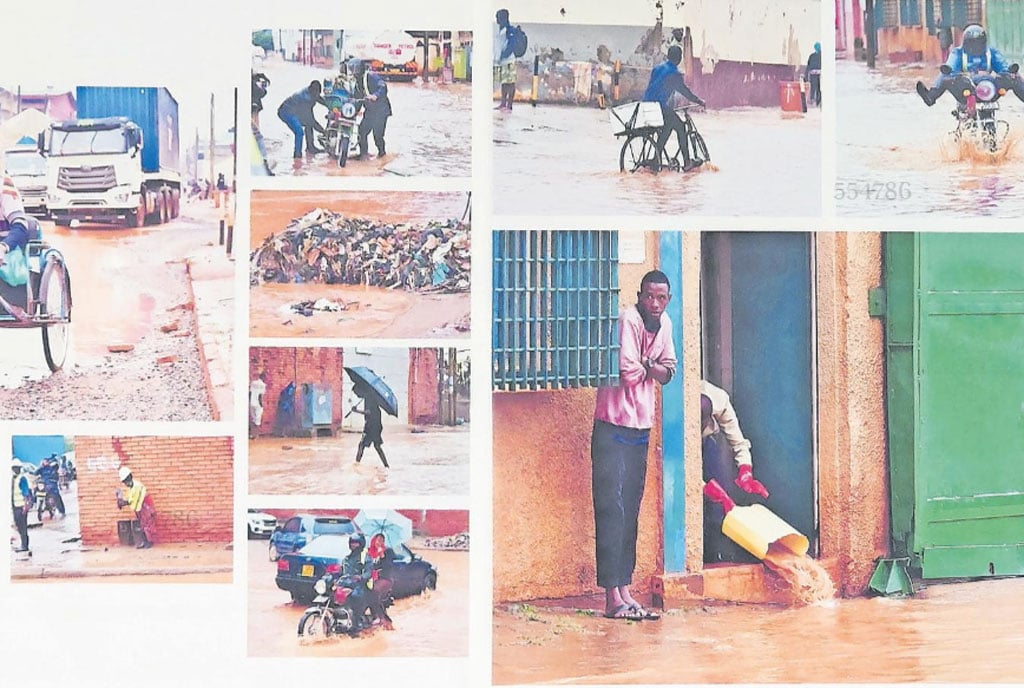Telling the East African story through the lens

A photomontage showing what happens in Kampala after downpour. PHOTOS/ABUBAKER LUBOWA
What you need to know:
- Hajar Nalwadda is documenting grief and hopelessness the community still faces shortly after the attack.
- Through pictures of abandoned and burnt items such as beds, you understand the grave nature of the incident.
Every year, some of the best East African photographers come together to celebrate a year in photography. This is usually through the Uganda Photography Awards and the East Africa Press Photo Awards, held annually in Uganda.
The celebrations bring together arts, creative, as well as photojournalism stories, which most of the time are a summary of the past 12 months in news.
After the awards, there is an exhibition of the winning entries. This year, the exhibition opened on October 17 at Motiv Uganda in Kampala. The UPPA winning entries have been on display at Motiv for a month and through the exhibition, one gets a deeper understanding of why these particular photo stories were outstanding.
For instance, Hajar Nalwadda’s entry, Lost, documents the aftermath of the Allied Democratic Forces (ADF) rebels’ attack on Mpondwe, Lhubirha Senior Secondary School in Nyabugando, Kasese District, on July 17, 2023.
Nalwadda is documenting the grief and hopelessness the community still faces shortly after the attack. Through pictures of abandoned and burnt items such as beds, you get to understand the scale and grave nature of the matter. At the time of taking the pictures, it is visible that some of the dead are still on the scene.
The photographer still manages to capture emotions, as well as that raw Ugandanness, which shows up in ways only a few can predict, such as having messages on our transport means, such as lorries and buses. Most of the time, these messages are just words on vehicles, yet there is always that time when they indeed make sense.
In one of Nalwadda’s pictures, mourners are on top of a van with the words, There’s Always Hope, which, of course, is not intentional for whoever hired the van but is a much-needed message for those in it.
It is not very surprising that Nalwadda was the overall winner.
Other stories on exhibition include David Lubowa's Wading through Broken Systems, which takes the lens to people living in Kampala and struggling with flooding roads. Lubowa’s picture story captures both the emotions, anxiety, people’s own struggle, and the state of the roads.
What makes the story work is the fact that Lubowa makes it a character in the story rather than just a canvas, where the whole story happens.
This is not the only flood story on the exhibition, which in one way or another says a lot about Africa, her infrastructure, and above all, climate change.
Tchandrou Nitanga from Burundi, who placed third in the East Africa Photography Awards, profiled floods that hit Gatumba District of Bujumbura in Burundi. On April 19, 2024, floods in Gatumba displaced more than 10,000 people into makeshift shelters and tents.
The exhibition closes this weekend.
Other stories include documentation of the Gen-Z protests in Nairobi, where the youth took to the streets to strike against a proposed financial bill. The protests, which started peacefully, eventually escalated into violent ones, with some people abducted in the process.
Another documentation of the protests looks at how much of the Gen-Zs were mobilised and used to send information to the world using mobile phones. The two stories, Kenya Financial Bill Protests and The Revolution, will be streamed by Kabir Dhanji and Peter Irungu and give different takes on the protests that took the region by storm.
There are other stories on governance and Uganda traditions, though it is the EAPA Human section, where most of the participating photographers were captured while capturing emotions and putting their message across, whether using double exposure to talk about mental health and general life.
Over the years, through workshops and mentorships, UPPA and EAPA have worked with some of the best photographers across different photography disciplines such as sports, creative, news, and life, among other fields.
Some have gone on to grace the biggest platforms with their works, while others have continued winning global photography accolades.
This year, most of the winning photographers were generally new names compared to the past editions.




